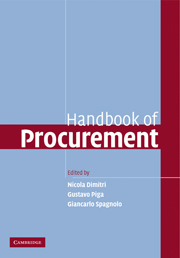Book contents
- Frontmatter
- Contents
- List of figures
- List of tables
- List of contributors
- Preface
- Part I Preliminary Issues
- Part II General Strategic Principles
- Part III Competitive Tendering Strategies
- 6 Information and competitive tendering
- 7 Division into lots and competition in procurement
- 8 Multi-contract tendering procedures and package bidding in procurement
- 9 Dynamic auctions in procurement
- Part IV Attracting and Screening Participants
- Part V Preventing Collusion and Corruption
- Part VI Dynamic Forces and Innovation
- Glossary
- Index
- References
9 - Dynamic auctions in procurement
Published online by Cambridge University Press: 04 November 2009
- Frontmatter
- Contents
- List of figures
- List of tables
- List of contributors
- Preface
- Part I Preliminary Issues
- Part II General Strategic Principles
- Part III Competitive Tendering Strategies
- 6 Information and competitive tendering
- 7 Division into lots and competition in procurement
- 8 Multi-contract tendering procedures and package bidding in procurement
- 9 Dynamic auctions in procurement
- Part IV Attracting and Screening Participants
- Part V Preventing Collusion and Corruption
- Part VI Dynamic Forces and Innovation
- Glossary
- Index
- References
Summary
Introduction
Procurements for many related items are commonplace. Dynamic auctions have many advantages in such environments. We consider both the purchase of many related items and the purchase of many divisible goods, such as energy products or environmental allowances, or other procurement contracts. In such auctions, the bids specify quantities of each of the items: the megawatt-hours of electricity or the tons of emissions. Often, related goods are – or could be – auctioned at the same time. In electricity markets, products with several durations or locations may be auctioned together. In environmental auctions, emission reductions for each of several different pollutants or time periods may be bought at the same time. This chapter explores how procurement auctions for many divisible or indivisible goods should be conducted. Of course, the answer depends on the objective of the buyer and the bidding environment. Here we focus on a few of the important issues of auction design in a setting where the buyer cares about some combination of efficiency (procuring the goods from the lowest-cost suppliers) and minimization of the payment for purchasing the goods. Our purpose is to motivate a sensible design in a realistic environment, rather than to prove the optimality of a particular design, which would require more restrictive assumptions than we care to make.
- Type
- Chapter
- Information
- Handbook of Procurement , pp. 220 - 246Publisher: Cambridge University PressPrint publication year: 2006
References
- 18
- Cited by



